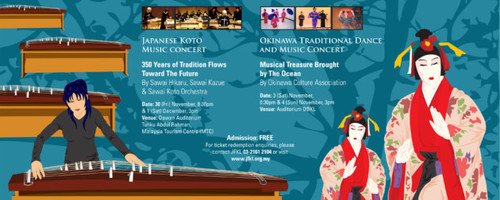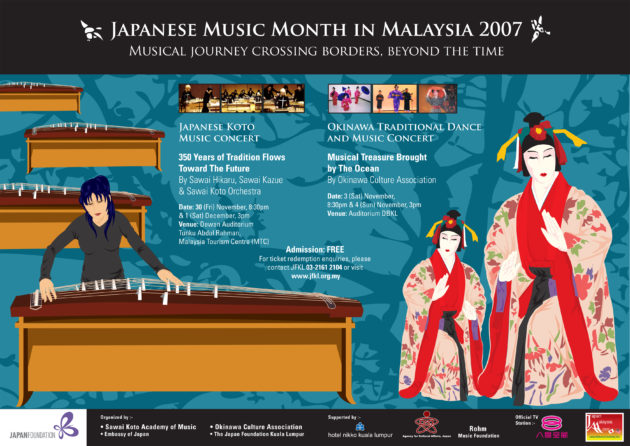Japanese Music Month in Malaysia 2007
“Musical journey crossing borders, beyond the time”
Okinawa Traditional Dance and Music Concert
Musical treasure brought by the ocean
By Okinawa Culture Association
We, The Japan Foundation KL proudly present a treasure of the very authentic traditional performing arts of Japan, Okinawan Dance and Music.
Okinawa is a tiny group of island in Southern part of Japan and it might not easy to locate in a world map. However, it has fostered unique culture, as distinct from that of mainland Japan.
The performing arts of Okinawa is an amalgam of the best of art styles from various lands, with which Okinawa had longtime trading ties; mainland Japan, China, Southeast Asia, etc. It is said that Ryukyu Kingdom of Okinawa had a close trading tie with Melaka Kingdom and sent missions frequently through 15-16 century. The most outstanding example of such an amalgam is KUMIODORI (music drama), which is designated by the Japanese government as an Important Intangible Cultural Asset. Perhaps the international popularity of Okinawan performing arts has its reason in this multinational origin and background.
In this concert, the Okinawa traditional dance and music players organized by the Okinawa Culture Association will show you the essence of beautiful, elegant and cheerful arts of Okinawa.
The details as below:-
Date: 3 (Sat) November, 8:30pm & 4 (Sun) November, 3pm
Venue: Auditorium DBKL
Admission: FREE
Ticket Redemption
Tickets will be issued on the day of the performance. However, we will be issuing Temporary Passes, which entitle you to exchange to the tickets, prior to the day of the performance.
(1) Temporary passes are available as follows:
a) WHERE to collect?
The Japan Foundation, Kuala Lumpur
Suite 30.01, Level 30, Menara Citibank, 165 Jalan Ampang, 50450 KL
Tel: 03-2161 2104
Opening Hours: 10am ? 6pm (Closed on Sunday)
b) WHEN to collect?
Okinawa Traditional Dance and Music Concert
From 26th October (Fri) ~
*Number of Temporary Passes available is limited
**The pass redemption is on first-come, first-served basis
***Limited four (4) passes per person only
****Preschoolers are not allowed to the show
(2) Walk-in Tickets are also available on the day of the performance. The ticket redemption starts one (1) hour before the show at each venue.
*Number of Walk-in Tickets available is limited
**The ticket redemption is on first-come, first-served basis
***Preschoolers are not allowed to the show
Organized by
? Okinawa Culture Association
? The Japan Foundation Kuala Lumpur (JFKL)
Supported by
? Embassy of Japan in Malaysia
? Hotel Nikko Kuala Lumpur
About the Okinawa Culture Association
Okinawa Culture Association, a non-governmental organization has committed to enhance Japan?s image abroad through the introduction of Okinawan performing arts since its establishment in 1989. It has organized Okinawan cultural missions every year to more than 25 countries in Europe, North, Middle and South America, Middle East and Asia.
Okinawan Traditional Arts
Traditional Okinawan dances consist of three types: Court dance, ZO-Odori and Folk dance. The Court dance originated from the ones in which people prayed in ancient days to gods for good harvest. Around the 17th century, the king of Okinawa called for the creation of court dance. At that time, Okinawa was an independent kingdom and established diplomatic relationship with China and Southeast Asian countries exchanging commodities and exporting/importing cultures in mutual friendship. The Sanshin (the most important three string instrument in Okinawan music) was imported from China. In the process of creation of the court dance, technics of Noh and Kabuki in mainland Japan were incorporated and movement of Southeast Asian countries was transferred. In this way, the court dance was completed being played solemnly in colorful purple cloths.
Zo-Odori (Semi Classical Dance) was developed in the Meiji era, when Japan opened its door to the rest of the world and began its modernization. After Meiji Restoration (1868), professional artists and dancers completed the Zo-Odori incorporating Okinawan classical music and folksongs.
The Folk dance, namely, is developed as common people?s dance. The dance is always performed in daily life to bring energy, hope and happiness. One of the folk dances, ?Kachashiee?, is the most joyful one, inviting the audience on the stage to enjoy the dance together in their own way.
The Kumiodori is a sort of court dance, a music drama which is developed by the melody and the words of the songs. The founder, Choukon Tamagusuku adopted the technic of Noh and Kabuki. He was in charge of traditional arts and obliged to visit Edo by order of the king of the Ryukyus. The Kumiodori was designated as National important intangible cultural asset like Noh and Kabuki.
(by Dr. MISUMI Haruo, President of Japan Folklore Association)




